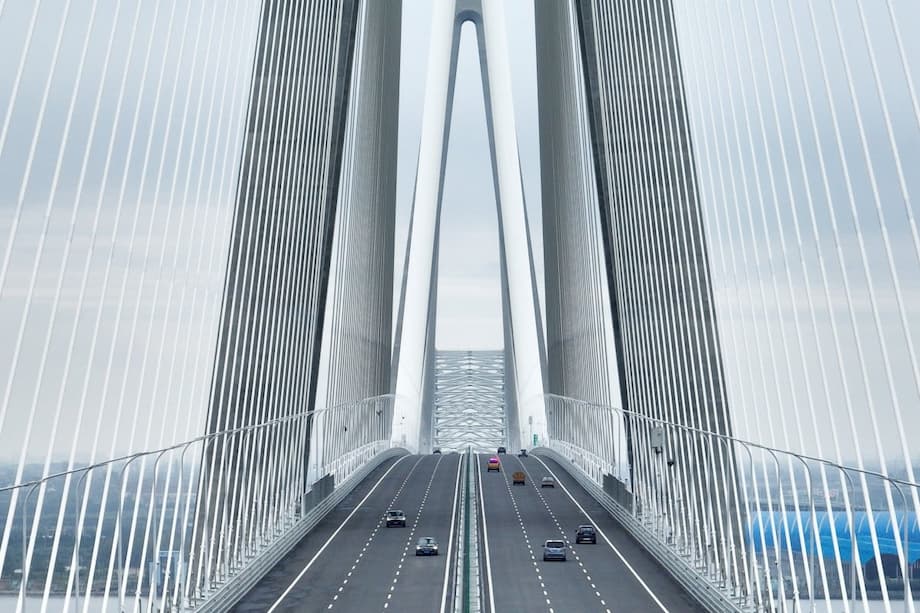A transformative link across the Yangtze
China has opened a new mega bridge across the Yangtze River that sets multiple world records and reshapes daily travel in eastern Jiangsu province. The Changtai Yangtze River Bridge stretches 10.3 kilometers (6.4 miles), tying the manufacturing city of Changzhou on the south bank to Taizhou on the north. The trip that once took about 80 minutes can now be made in roughly 20 minutes. The main span measures 1,208 meters (3,960 feet), which makes it the longest span of any cable stayed bridge in the world. The bridge is the first over the Yangtze to carry an expressway, a regular road, and an intercity railway on the same structure, a rare combination that demanded new design ideas and construction methods.
- A transformative link across the Yangtze
- Why the project matters for Jiangsu and the Yangtze Delta
- Inside the record span and mixed traffic layout
- Balancing an asymmetric deck
- Foundations built for a powerful river
- Towers, cables, and materials
- Precision construction and millimeter targets
- What travel will look like on day one
- How it compares to other landmark bridges
- Key Points
Construction took about six years. The project team introduced a series of first of their kind technologies to deal with deep soft soils, strong river currents, and the challenge of combining road and rail traffic on a single deck. The structure also includes two steel truss arch bridges with 388 meter spans for the auxiliary channels, which set records for a dual use highway and railway arch. The main towers rise to 350 meters (1,148 feet), about the height of a 120 story building. Before opening, engineers completed an extensive program of static and dynamic load tests, laying the groundwork for safe operations from day one.
Why the project matters for Jiangsu and the Yangtze Delta
The Yangtze River Delta is one of China’s most productive regions. A fast and reliable crossing between Changzhou and Taizhou tightens links in a corridor where factories, logistics parks, and technology clusters sit on both riverbanks. Shorter trips reduce transport costs, enlarge labor markets, and make regional public services easier to reach. The new route also offers relief to existing bridges and ferries that have carried rising volumes of people and freight.
Officials in Jiangsu describe the bridge as a key connector in a larger program to knit together the delta’s road and rail networks. The province reports that 20 river crossing passages are now complete and nine more are under construction. National plans envision a much denser grid along the Yangtze, with a goal of about 240 crossings by 2035, which will distribute traffic more evenly and provide multiple alternatives during maintenance or extreme weather.
Navigation and ecology were central to the design. A very long main span keeps the central navigation channel free of piers, which helps large vessels pass safely and reduces in river disturbance. The project team selected foundation and tower solutions that limit the footprint in deep soft sediments and control scour, the process by which fast moving water strips away riverbed material around foundations.
Inside the record span and mixed traffic layout
A cable stayed bridge supports the deck with fan like arrays of steel cables connected directly to tall towers. It differs from a suspension bridge, which uses main cables draped over towers and anchored to the ground, with vertical hangers attaching the deck. Cable stayed systems are efficient for very long spans of roughly 200 to 1,300 meters, deliver a stiff deck, and need smaller anchorages, which suits dense urban settings and heavy rail loads.
Changtai’s headline feature is its integration of three transport functions in one structure. The configuration uses two levels. The upper level carries an expressway that speeds cross river highway traffic. The lower level combines an intercity railway designed for 200 km/h (124 mph) with a standard road running alongside it. This side by side arrangement on the lower deck is a first at the scale of a span longer than a kilometer.
In conventional mixed use bridges, the railway usually runs down the center with road lanes split on both sides. Central placement simplifies balancing because rail systems weigh much more than roads. The trade off is awkward traffic geometry at both ends of the bridge, where split roadways must loop around to rejoin. That consumes land, complicates ramps and junctions near urban districts, and can slow emergency access. The new layout keeps the road and rail on one side by side deck, creating cleaner links into city streets and stations.
Balancing an asymmetric deck
Placing a high speed railway on one side and a road on the other creates an uneven mass distribution. The rail side is several times heavier, which tends to twist a deck and pull it out of line if not carefully countered. Qin Shunquan, chief scientist at China Railway Group and the bridge’s lead designer, and his team addressed this by fine tuning cable forces to hold the deck level under permanent loads and by adjusting the geometry of prefabricated deck segments.
When cable forces are increased on the heavy side, the structure can shift toward the lighter side and the deck’s centerline can move. Engineers compensated for these tendencies with a calibrated sequence of segment assembly and pre set shapes so that, as segments were erected and the stay cables were stressed, the deck naturally straightened to the intended alignment. This approach allowed the first side by side rail and road layout on a large span bridge without resorting to more complex multi deck splitting schemes.
Foundations built for a powerful river
The Yangtze is wide, deep, and dynamic near Changzhou and Taizhou. Foundations must resist currents and stand in thick layers of silty clay and sand. The main towers sit on giant open caissons, essentially hollow boxes of steel and concrete that are sunk into the riverbed. The project adopted a step type caisson base that reduces scouring around the structure and cuts self weight, which in turn lowers installation risks. Early calculations pointed to sinking more than 65 meters deep to reach sufficient bearing layers. New techniques developed by the team allowed engineers to trim the caisson height while keeping stability.
Academic studies based on the Changtai site show how the foundations behave during construction. Researchers used three approaches to estimate settlement, which is the downward movement that occurs as soil consolidates under load. They applied a layer wise summation calculation, ran three dimensional finite element simulations, and performed centrifuge model tests. All three methods predicted final settlements of about 225 millimeters after the full superstructure was installed, with a curve that moves through slow increase, rapid increase, and stabilization stages. These values were within design allowances and helped confirm that the installation sequence would keep the bridge aligned.
Underwater positioning is difficult in low visibility and strong currents. To reduce hazards for divers and improve accuracy at the caisson corners, the construction team deployed intelligent robots that could navigate, remove in filled sand, and relay measurements. These tools aided operators on the surface and shortened critical steps during sinking and seating of the foundations.
Towers, cables, and materials
The two main towers are diamond shaped and use a steel and concrete composite system to combine stiffness with ductility. The unusual geometry increases stability and helps transfer loads from the stay cables to the foundation while controlling movement under wind and temperature changes. A steel box core concrete cable anchorage system spreads forces efficiently and limits stress concentrations where the stays enter the tower.
New materials feature prominently. Engineers applied carbon fiber tendons to create lightweight, high strength, ultra long cable elements that are less sensitive to temperature swings than steel alone. The project also introduced a temperature adaptive longitudinal restraint system at the connection between tower and beam, which allows controlled movement as the deck expands and contracts through seasonal heat and cold. Design documents cite a total load capacity in the hundreds of thousands of metric tons, which accounts for the structure itself and heavy traffic loads. These choices help the bridge perform consistently through daily cycles and extreme weather.
Precision construction and millimeter targets
Building a kilometer scale steel truss and cable system with mixed traffic required industrialized methods. The team developed an intelligent tower crane with a lifting capacity over 10,000 tonne meters to work high on the pylons and guide large components into position. They also designed what they describe as the world’s largest deck crane for bridge work, which could place ultra heavy segments with millimeter level accuracy. The main channel’s steel truss closure was welded with a final alignment tolerance within 2 millimeters, a precision achieved through continuous survey control and digital feedback.
Factories feeding the site used large scale automated production lines, 3D laser scanning inspection, and standardized welding to hold quality. Before opening, the bridge underwent a week of load tests at night to reduce temperature effects on measurements. The most intense test placed 110 loaded trucks weighing about 4,400 tonnes across the main span. In total, engineers staged over 200 static and dynamic scenarios and monitored responses with more than 800 sensors, tracking tiny shifts across all sections. The bridge passed its final checks and opened to traffic after the tests validated structural performance.
Complex construction also hinges on reliable energy supply. The State Grid Taizhou Electric Power Supply Company formed a support group for the project, expedited service requests, carried out drone line inspections, and used live working methods and infrared temperature checks to keep power stable. That operational backbone helped the site meet tight schedules and maintain safe lighting and equipment power during multi shift work.
What travel will look like on day one
The bridge is designed to carry an expressway, a city road, and an intercity rail line with a top operating speed of 200 km/h. The new route brings downtown Changzhou and Taizhou within a predictable 20 minute trip and creates a more direct path to airports, ports, and industrial zones on both sides of the river. Freight haulers gain a high capacity link that avoids circuitous detours to older crossings.
The side by side arrangement of the railway and road on the lower deck simplifies ramps and emergency access near the approaches. Both decks are instrumented for structural health monitoring so that operators can watch for changes in cable forces, bearing movements, and deck vibrations in real time. Expansion joints and bearings are tuned for temperature range and wind. The combination of stiff truss decks, dense sensor coverage, and conservative load factors supports smooth operations even under heavy traffic and seasonal river winds.
How it compares to other landmark bridges
The Changtai main span of 1,208 meters surpasses the Russky Bridge in Vladivostok, Russia, which has a cable stayed main span of 1,104 meters. Longer spans exist in the category of suspension bridges, such as Turkiye’s 1915 Canakkale Bridge with a 2,023 meter main span. Choosing a cable stayed system for Changtai reflects the need for a very stiff deck that can carry high speed trains next to highway traffic, along with a desire to limit the land take required by massive suspension anchor blocks.
China has built more than a hundred large bridges along the main stem of the Yangtze. The goal to reach about 240 crossings by 2035 illustrates how fast growing regions spread traffic loads across many routes rather than relying on a few choke points. With its record span and mixed traffic layout, Changtai adds a new template for future crossings where dense urban connections favor a compact, multi function structure.
Key Points
- Length is 10.3 kilometers (6.4 miles), tying Changzhou and Taizhou across the Yangtze River
- Main span is 1,208 meters (3,960 feet), the longest for a cable stayed bridge
- First Yangtze crossing to combine an expressway, a regular road, and an intercity railway on one structure
- Lower deck places a 200 km/h (124 mph) railway and a road side by side, a first at this scale
- Main towers are 350 meters (1,148 feet) tall with a diamond shaped composite design
- Two auxiliary channel bridges use 388 meter steel truss arches that set dual use records
- Giant open caisson foundations in silty clays showed final settlements near 225 millimeters in studies
- Construction innovations included an intelligent tower crane over 10,000 tonne meters and a largest deck crane
- Closure accuracy of the main truss was within 2 millimeters, verified by 3D laser and survey control
- Load testing used up to 110 trucks totaling about 4,400 tonnes, with more than 800 sensors monitoring response
- Travel time between the two cities falls from about 80 minutes to roughly 20 minutes, strengthening the Yangtze Delta network




